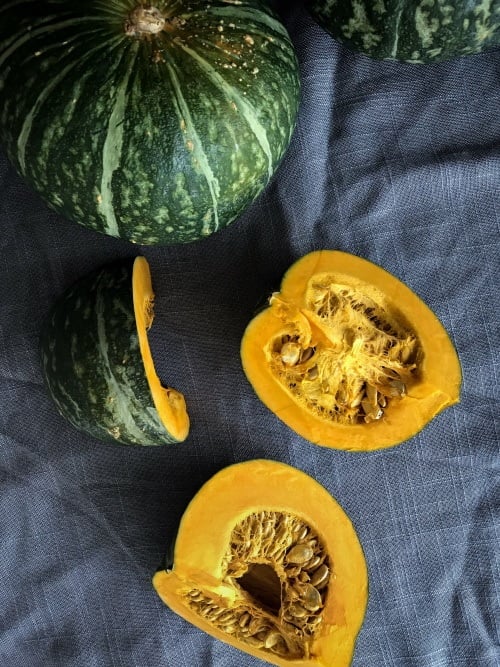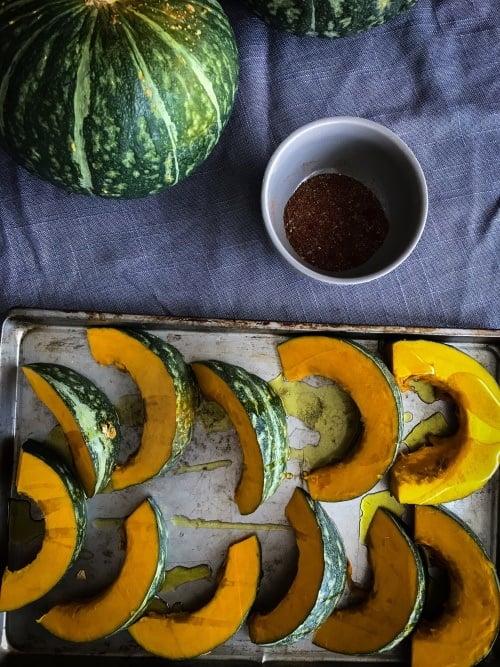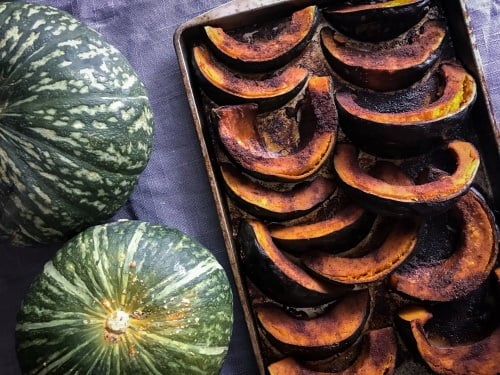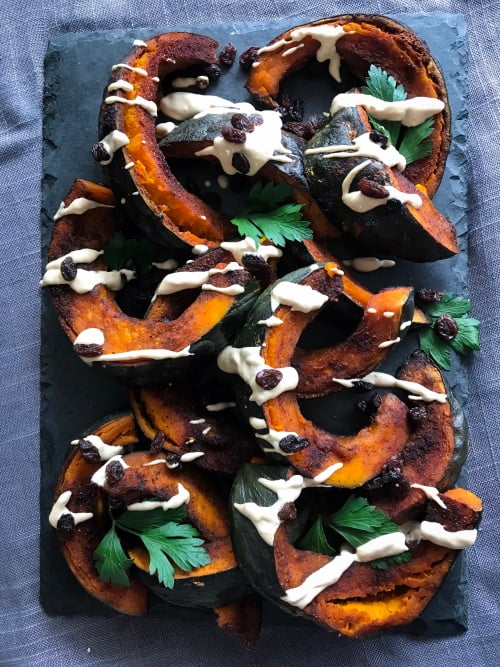Kabocha, literally meaning pumpkin, is a winter squash otherwise known as the Japanese pumpkin. This vegetable has been used in many different ways in Japan and other Asian countries. One of the most popular ways is breading in a light tempura batter coating and frying. In Thailand, this squash is either puréed to thicken curries or used in chunks to add flavor and texture. It is also used in desserts.
The versatility of kabocha is incredible. It can be steamed, fried, baked, roasted, puréed, and braised. Believed to be first discovered in South America, the squash was brought to Japan by the Portuguese in the 16th century. The squash pairs well with so many different flavors, among them sage, pear, apple, lemon, eggplant, kale, garlic, nutmeg, curry, parmesan, and so many more.
Where to find kabocha squash:
You should be able to find kabocha in a well-stocked supermarket like Whole Foods or a local Asian market. You might get lucky and find them at your local grocer too! If you run out of luck, Fresh Direct delivers them to some areas!
What does kabocha squash look like?
Kabocha has a shape similar to a pumpkin with green, striped skin that feels thick but is thin enough to eat when cooked. The inside is a deep orange color, and it is lined with seeds on the inside similar to a pumpkin.

How to store kabocha squash:
Store your kabocha in a dark, cool place until ready to use. Once sliced, the squash should be stored covered in the refrigerator. To pick the best kabocha, look for one where the skin is a deep green with no moldy spots. The squash should feel heavy and have golden speckles and streaks on its rind.
How does kabocha squash taste?
Kabocha’s consistency is somewhere between butternut squash and pumpkin, and the flavor is somewhere between sweet potato and pumpkin. When cooked right, it’s soft, sweet, and creamy with a velvety fluffy texture and a buttery flavor. YUM!!!

Is kabocha squash good for me?
Besides for being a good source of vitamin A, iron, and vitamin c, kabocha also contains some vitamin b and is rich in antioxidants. At 40 calories per cup, this squash is the perfect way to add sweetness without adding all of the carbohydrates than butternut squash contains.
How to slice and dice kabocha squash:
Kabocha’s rind is safe to eat but can be hard to slice into before cooking. Here’s how to prepare your kabocha safely:
1. Scrub the rind with warm, soapy water to wash off all the wax and dirt.
2. Using a sharp knife, create a flat surface by slicing off a piece of the bottom or top. This prevents the squash from wobbling.
3. Slice off any brown knobbles. They don’t taste good.
4. On a flat surface (such as a cutting board), use your knife to slice into the kabocha. Maneuver your knife through the squash to create a circular cut around the width of the squash. You may need to rock the knife back and forth to help complete the process. To make this a little easier, you can start the cooking process by heating the squash in the microwave for two minutes on each side. Don’t force the knife too hard. This can cause slipping of the knife, which may lead to injury.
5. One your kabocha is halved, scoop out the seeds, and either discard or save for roasting later.
6. Then slice the kabocha as desired, whether it be crescent shaped slices, dices, or just left in halves.

Some Ways to Prepare Kabocha Squash:
Roast it: you can roast it whole, slice it, dice it, or cut it in half and roast it skin side up. We prefer to roast at 400°F for 45 minutes or until fork tender. I love adding the diced roasted bits to winter salads or grain bowls.
Add it to a stew instead of potatoes, serve up a stew, curry, or even cholent with some kabocha cubes.
We love putting a large chunk into our chicken soup for Shabbat to add some sweetness.
Bake it— any way you would use pumpkin or squash like in a gratin, kugel, or as “fries” would totally work.
Purée it as a side or base of a plated dish, or use the purée to thicken a soup or stew.
Use it wherever you would use pumpkin—kabocha pie anyone? Kabocha gnocchi? Mashed kabocha? Kabocha soup?
Roast the seeds with a little oil, salt, and pepper along with your favorite spice rub. Eat them as a snack, or use them top your favorite salad or soup.
Candy it! Dice the kabocha, drizzle with olive oil or butter, and sprinkle with brown sugar, a pinch of cinnamon, and a little salt. Roast in a single layer on a cookie sheet for about 50 minutes at 375°F until the squash is caramelized and the sugar is browned and bubbly. Stir every 15 minutes while cooking so the squash doesn’t burn.
Kabocha Squash Recipes
Still looking for kabocha inspiration? Try one of these recipes.
My favorite kabocha soup recipe involves taking the flesh of a roasted kabocha and mixing it with one sautéed leek, three cloves of grated garlic, and three cups of broth. Season with salt, pepper, and one teaspoon of curry powder or five spice power, and blend until smooth. Serve with your favorite meatballs and sliced scallions on top!
We also love kabocha kugel as an alternative to a sweet kugel or crumble. Try this recipe:
Kabocha Kugel
Ingredients:
1 whole kabocha, roasted and puréed
3 eggs
1/4 – 1/2 cup brown sugar
1/2 cup flour
Directions:
1. Mix ingredients, and spread into an 8”x8” baking dish.
2. Add ½ teaspoon cinnamon or pumpkin pie spice to top or your favorite streusel topping.
3. Bake for 60 minutes uncovered at 350°F
Roasted Kabocha with Raisins and Tahini
I love that this recipe has so many great flavors but is still super simple. It’s the perfect winter side that is still light (and not a kugel.) I use the McCormick brand of Garam masala, but if you can’t find it, you can use pumpkin pie spice or Chinese five spice instead. I add in a little sugar to make the sweetness of the kabocha pop and add a little caramelization, but if you prefer to leave it out, feel free! The kabocha is usually sweet enough without it.
Get the recipe
Ingredients:
1 large kabocha, sliced into thick wedges (approximately 14-16 slices) seeds discarded or saved for another use
2 teaspoons raw sugar
2 teaspoons garam masala
1/2 teaspoon smoked paprika
1/2 teaspoon garlic powder
1/2 teaspoon cardamom
Kosher salt to taste
Freshly ground black pepper
3-4 tablespoons olive oil, for drizzling
1/4 cup raisins
2-3 tablespoons tahini paste
Directions:
1. Preheat the oven to 425°F, and line a baking sheet with parchment paper.
2. In a small bowl, mix the spices, salt, and sugar together.
3. Lay the squash down in a single layer. Sprinkle with spice mixture. Drizzle with olive oil.
4. Cover with a foil sheet, and roast for 20 minutes covered. Remove the foil, and roast for 25 minutes uncovered or until crispy.
5. Lay on a platter, and drizzle with tahini paste.
6. Top with parsley and raisins.
7. Serve warm or room temperature.






